#programme of bristol old vic
Text
In the Footsteps of a Saint

FAITH TODAY:MAY 2011
Catholic actor Charlie Cox is making waves across the Atlantic – and he’s about to hit the cinemas in his native UK playing a saint in a new movie.
FAITH TODAY went to meet him.
How does it feel to be a saint? That’s something no-one alive can ever really know, since sainthood is only acknowledged after death: but up-and-coming actor Charlie Cox knows more about it than most.
Cox, 28, is the star of There Be Dragons, a new movie about the early life of St Josemaria Escriva, the Spaniard who founded Opus Dei. So – given that he’s a Catholic himself - how did it feel to Cox to walk in a saint’s shoes, and to portray his holiness on screen?
What struck him most, says Cox, is that ‘there seemed to have been no single moment when Josemaria was saintly... instead, what people who knew him spoke about and wrote about was a lifetime of consistently good decisions and a dedication of his entire life to God’. So in fact, he explains, portraying him meant being very human – and yet aware that decisions often had to be made that weren’t directed at other people, but were directed at God.
Playing Josemaria is the latest step on a path that’s fast feeling like the road to the big-time: Cox first appeared on the showbiz radar in 2007 when he got the role of Tristan Thorne in the movie Stardust, and he went on to play the Duke of Crowborough in the ITV drama Downton Abbey. And just a fortnight before we meet, he’s filmed his first episode of HBO’s prohibition drama Boardwalk Empire, the flagship programme of the new Sky Atlantic channel, in which he plays an immigrant from Northern Ireland with ties to the IRA. Cox says he’s loving the part: Steve Buscemi, who recently won a Gold Globe award for his portrayal of Enoch ‘Nucky’ Thompson in the series, is one of his all-time heroes, and he can hardly believe his luck in being cast with him.
’Working with Steve feels amazing, I can’t believe how lucky I’ve been,’ he says, as we chat over coffee at a Madrid hotel on the morning of the premiere of There Be Dragons. He jetted in this morning from New York – he’ll be there filming Boardwalk Empire through the summer and, he says, he can’t imagine a better way of spending the next few months. ‘They’re the nicest bunch of people – and everyone is so confident about how good the series is, so there’s a great buzz about it.’
Working on Boardwalk Empire has taken him a long way from his Sussex roots. He grew up in Hearst Green, the son of publisher parents – and he was raised a Catholic, like his father, although he was educated at a non-Catholic independent school, Sherborne School in Dorset. ‘Only about 70 out of 700 boys were Catholics. We had to get up early on a Sunday to go to Mass at a local girls’ school... it would have been easy to skive off it, but actually we never did. I’ve always loved churches – even now, in a strange city, I’ll often wander around looking at churches.’
There was no history of acting in the family – bar a grandmother who had been at RADA before the second world war – but even as a youngster, Cox was smitten with the idea. ‘My mum and dad had a fantastic attitude to it,’ he says. ‘The school wanted me to go to university, play it in safe mode, have a back-up plan. But my parents came to see me act, and afterwards my dad sat me down and he said: ‘I think you’d be a fool not to pursue this’. And I don’t know whether I’d be here now if it hadn’t been for that one comment...’
Despite living in the US at the moment, and the fact that his parents spend most of their time these days in France, Cox says Britain will always be home – and he’s very close to his family. He has a brother, and three half siblings from his father’s first marriage, and his parents have flown to see him in Madrid while he’s over for the premiere of There Be Dragons.
After school, he spent a gap year working for a photographer – and even before he could take up a place at Bristol Old Vic Theatre School, he’d landed the role of Theo in the movie Dot the i. ‘An agent took a punt on me and put me up for the part,’ he says. ‘I’ve been incredibly lucky, and that was just one of my lucky breaks.’
But it’s not just luck – Cox is immensely likeable, and he’s obviously genuinely passionate about acting. He’s also been smart enough to realise that he can learn a huge amount from more seasoned actors – so he saw acting alongside Robert de Niro and Michelle Pfeiffer in Stardust, for example, as a fantastic opportunity to soak up knowledge. And he’s learnt lots more, too, from Roland Joffe, director of There Be Dragons, who was also the film-maker behind The Mission (about the early Jesuits in south America) and The Killing Fields (about the murderous Pol Pot regime in Cambodia), both of which were Oscar nominees.
‘I didn’t think twice about taking the part of Josemaria, and that was down to Roland,’ he says. ‘He’s such a great director – he really understands the processes that actors have to go through to give their best. I learnt so much from working with him.’
Given the subject-matter of There Be Dragons, Cox also spent time in the run-up to filming learning about Opus Dei, which has the status of a ‘personal prelature’ within the Catholic Church. ‘I visited several Opus Dei houses, and I went on a retreat and had a lot of help from an Opus Dei priest, Fr John Wauck.’
Before he made the film, he admits, he’d never heard of Josemaria – and all he knew about Opus Dei was what he’d read in Dan Brown’s book The Da Vinci Code. But researching Josemaria, he says, what struck him most was the saint’s humanity – and his ability, examined in the film, to forgive. ‘It was an example I had to put into practice, because one day when we were filming I returned to my trailer to find someone had broken in and cleaned the place out completely,’ he says. ‘They’d even taken my computer, and the charger, and even my clothes.’
‘The following day I was due to film one of the big scenes in which Josemaria shows how he can forgive, and I remember thinking: this is really interesting. And the thing is that I did manage to forgive the guy who nicked my stuff.’
‘And what I realised, through that incident, was that – though we think of forgiveness as something very moral and impressive, it’s actually something that works totally in your own favour. Because if you don’t forgive then you’re angry inside – and that anger doesn’t hurt the other person, but it really hurts you.’
Since filming finished for There Be Dragons, Cox has been working on another movie – Moby Dick, due to be released later this year – and now Boardwalk Empire. It all suggests, I tell him, that fame – which he’s told previous interviewers frightens him – could be beckoning. ‘It’s tricky,’ he says, candidly. ‘I’ve got friends who have gone on to extraordinary fame, and what I’ve realised through them is that it’s never quite as appealing as it promised to be.
‘On the other hand, like everyone else I want recognition. I like people to think I’m good at what I do. That’s human nature, isn’t it?’
~*~
#just me archiving another old interview 😊#had to check I didn't have this one yet but no I don't xd#thank you so much to Charlie's parents for supporting him in becoming an actor from the start 🙏💕#charlie cox#josemaria escriva#there be dragons#baby charlie#interview#article
31 notes
·
View notes
Text
London's £150 theatre ticket problem
Recently, Andrew Scott spoke up about the £150 theatre tickets that are on sale across West End shows. I mean, apart from glaring inaccuracies in the article ("Tickets for Plaza Suite, which stars husband and wife Matthew Broderick and Sarah Jessica Parker, cost from £125 to £395." is just untrue - unless when I paid £35 for my ticket, I somehow spent £125...), statements like this are simply misleading. And in my opinion, actually do more harm to the public's perception of theatre than good.
This is not defending £150 theatre tickets - the pricing of which is a whole other discussion. It's that £150 is practically never the average price of a ticket, practically never the price that most tickets are for one performance of 600+ seats and according to The Stage's report, just slightly above the average MOST expensive ticket.
The average cheapest theatre cost in the West End is around the £25 mark, according to SOLT. I'm not one to decide whether £25 is affordable, accessible or whatever. But £25 for a West End show, one that is deemed by the public at large to be the best quality in the world on par with Broadway, seems reasonable to me.
Celebrities and other major names saying that tickets are £150 is harmful for many reasons. One being that reading hot statements like that, from the average non-theatregoing joe public member's point of view, may reinforce the idea that theatre is not for them. That theatre is too expensive.
But a gentle reminder that the West End is not the only theatre you can attend is rarely mentioned. Across the UK, there are 100s of theatres putting on full programmes of productions throughout the year. And most of their ticket prices don't even graze three figures.
It's the public's perception that the West End is high-quality (not always), the West End is the best theatre that can be produced (not always) and that anything that isn't in London, and specifically the 39 West End theatres, must be made by amateurs and wannabe theatremakers.
Under 30s, for example, at Chichester Festival Theatre can enjoy £5 tickets across all their productions throughout the year. Theatre Royal Bath's tickets range from £9 to £60. Bristol Old Vic's tickets rarely exceed £60. Here, I've listed you three producing (and receiving) houses who have shows that regularly, with high regard, transfer to the West End. That place where, once it hits those theatres, it is suddenly of high quality. It's suddenly recognised.
And even then, it's worth reminding ourselves, despite The Guardian's article, that £150 for a show in London is not normal. And that's not even mentioning places in London like the Royal Court who have cheap tickets, and develop high quality shows. Or the Lyric Hammersmith. Or the Bush Theatre. Or Southwark Playhouse. There's so many options to experience theatre at a fraction of the price, and receive high quality entertainment.
Even for shows with big celebs £150 is not the only option. There are times when it's often the only price band left, sure. But that's the unfortunate repercussions of shows with big celebs - they attract crowds who purchase the cheaper tickets faster.
Maybe we should start questioning actors and producers who select to do high profile shows in London, where rates and stakes are higher rather than grassroots theatres across the country. We know that X famous actor in Y show in Z London theatre will have extortionate tickets. That's less likely to happen in a producing house across the country.
Why don't we start questioning the intention of the production? Ultimately theatre is a business, and that's why. The rest of London relies on theatregoers - much like the towns & cities other theatres are located in - but remove Matt Smith, David Tennant, Tom Holland and everyone else in major West End shows and there's a knock-on effect elsewhere. But no one does ever seem to ask "why does this have to be produced in London?".
Anyway, there are cheaper tickets available in the West End. And that's just an unfortunate fact some clickbait-led folks will just have to accept.
Sure, saying "actually there are cheaper tickets available" (even in the West End) doesn't make the news, doesn't get clicks and certainly doesn't drum up engagement.
I also really can't be bothered to get into "it's only the shit seats that are cheap" because you and I both know you're only kidding yourselves at this point. It's been proven untrue so many times. I also don't want to nod to rush ticket and on the day lotteries because as someone based regionally, I know this just isn't an acceptable way to purchase tickets for most of the country.
But I think it's probably worth noting, for the future of theatregoers, the future of our 16-25 year olds that Andrew Scott mentions, and the future of theatre at large, that £150 is by no means the average ticket price, the expected ticket price or the only option.
0 notes
Photo




KING LEAR
produced by John Moody
directed by Patrick Robertson
Bristol Old Vic
Tuesday, February 14th, 1956
For Three Weeks
Eric Porter
as Lear, King of Britain
Phyllida Law
as Regan
Peter O'Toole
as Duke of Cornwall
- programme -
***
Phyllida Law:
Emma Thompson and Sophie Thompson are her daughters.
Phyllida LawさんとはLook Back in Anger(↓)でも共演しています。
https://myfavoritepeterotoole.tumblr.com/post/612167344295477248/look-back-in-anger-written-by-john-osborne
**
ついでながら、一番下の画像は今回投稿のKing Learとは全く関係ないのですが、Phyllida Lawさんが結婚した時の集合写真にPeterが写っていると数年前に知って以来、どこにいるのだろうと何度も見返している画像を自分のメモとして一緒に投稿しておきます。(画像があまりに小さいため、それらしき人は見当をつけたものの、確証が得られないまま今に至っています)
画像とその説明のsourceはUniversity of Bristolのwebsiteです。
the wedding of actress Emma Thompson’s parents
outside St George's on Brandon Hill, Bristol on Saturday 25th May, 1957
photo by Desmond Tripp
A photograph of the wedding of actress Emma Thompson's parents, Phyllida Law and Eric Thompson, has been given to the University of Bristol Theatre Collection after its owner, C H Smith of Filton, paid a visit to the collection's current exhibition - The A-Z of Bristol Old Vic.
The picture shows them with their family and friends, mainly from Bristol Old Vic Company, including Peter O'Toole, Wendy Williams, John Woodvine and Edward Hardwicke, as well as Mr Smith himself.
- Press release issued: 17 July 2003
** memo **
これまでに集めたProgrammes of Bristol Old Vic
https://myfavoritepeterotoole.tumblr.com/post/186625687752/programmes-of-bristol-old-vic-the-matchmaker
#king lear#programme of king lear#bristol old vic#stage#1956#programme#my collection#peter o'toole#wendy williams#john woodvine#edward hardwicke#c h smith#phyllida law#eric thompson#desmond tripp#programme of bristol old vic
6 notes
·
View notes
Text
Moments in the 2019 Bristol Old Vic stage production of Cyrano that made me lose my MIND-
The opening scene starting at the convent instead of the theatre with the plot being told as a flashback (Cyrano’s actor seeming kinda out of it, which of course became HEARTBREAKING when the scene was played out again at the end)
The production working Patrycja Kujawska’s Polish accent into the storyline by making Christian Polish instead of just a new Gascon cadet
“Ballad of the Duel in the Bourgignon Theatre between Monsieur Bergerac and ✨une Tosseur✨”
Roxane excitedly telling the audience Cyrano is her cousin as she ran through it
Roxane describing the object of her affection as handsome and Cyrano’s actor hunching over slightly and sounding breathless as he repeated “handsome…” like she legit punched him
Honestly just the way Tristan Sturrock played Cyrano, man really had the 🥺 face right
Cyrano going “handsome fucker isn’t he?!” to the audience in complete disbelief when shaking Christian’s hand
“I need some motherfucking ELOQUENCE!”
De Guiche being completely incapable of pronouncing Christian’s surname
“I love you.” “You’ve said, expand!” “I love you…” *puppy head tilt* “Loads.”
Roxane telling Christian he talks crap and ordering him to “vanish”
The ENTIRE balcony scene, from Cyrano tapping his heart when he talks about Roxane changing her hair is set down in his memory forever, to Christian and Roxane slowly circling each other and reaching out for one another as Cyrano delivers his speech, completely oblivious and near tears with happiness that she’s finally listening UGH MY HEART-
Christian falling off the balcony with Cyrano trying to hold him up as the monk comes on stage. Cue awkward pause and “…good evening.” 😂😂
The “Man from the Moon” skit. All of it.
Cyrano, Christian and De Guiche looking absolutely terrified of Roxane being on the battlefield, with all 3 of them imploring her to leave 
Christian realising what’s happened with the letters and sending Roxane off to entertain the troops before folding over onto his knees and screaming “CYRANO!” into the silence 😭
“I want to be loved for myself, or not at all.” *cue me sobbing into my programme*
The tiny beat of dead silence when Roxane hears Cyrano’s slip of the tongue with “was” before EXPLODING into screams and trying to crawl across the stage to get to him
De Guiche being the one to hold her so she doesn’t get hurt 🥺😭
Cyrano slowly sliding down the side of the stage like he’s in physical pain while saying the infamous “yes Roxane… yes Roxane…”
Cyrano begging De Guiche to save Roxane and De Guiche just nodding in determination (now *there’s* a redemption arc)
THE ENTIRE CONVENT SCENE - especially with us basically seeing the first scene again but with added context and ✨ANGST-✨
“Your eyes are closed… how can you possibly be reading?”
Cyrano trying to comfort Roxane throughout the entire thing
“I was loved all along, beyond my wildest dreams.”
“Christian will be there, and we three, when you join us love…” said while collapsed in a heap and pointing wildly to the heavens I cRY- 😭😭
The change to the final line from “my panache” to “our panache” with Cyrano faintly smiling at Roxane
I just have a LOT of love in my heart for this version okay?? 😭😭


#there has to be a recording of it I WANT IT#Cyrano#Cyrano de Bergerac#Bristol old vic#Theatre#Tristan sturrock#Sara Powell#patrycja kujawska
46 notes
·
View notes
Link
Thursday night could become National Theatre night, as the company announced plans to broadcast some of its most popular productions for free during the lockdown.
The new two-month National Theatre at Home programme will begin with One Man, Two Guvnors, the Richard Bean comedy starring James Corden.
The films will be shown at 7pm every Thursday to try to recreate, where possible, the communal viewing experience. They will then be available on demand for seven days.
Lisa Burger, the executive director and joint chief executive of the National Theatre, said writers, actors and directors had all waived their rights to the productions.
“Everyone has said yes. Please. Let’s get it out to people,” she said. “It has taken a bit of negotiation and management but the outpouring from the industry has been fantastic.”
The shows will be available to watch on YouTube. They kick off on 2 April with a play regarded as one of the most joyously laugh-out-loud shows of the last decade.
One Man, Two Guvnors, directed by Nicholas Hytner, is Bean’s 2011 adaptation of Carlo Goldoni’s 1746 comedy and a brilliant vehicle for Corden’s stage comedy skills. The Guardian’s Michael Billington, giving it five stars, wrote: “The result, a kind of Carry On Carlo, is one of the funniest productions in the National’s history.”
That will be followed by Sally Cookson’s adaptation of Charlotte Brontë’s Jane Eyre, a production that began at Bristol Old Vic; Bryony Lavery’s adaptation of Treasure Island which was the National’s Christmas show in 2014, and the 2017 Twelfth Night, which starred Tamsin Greig as Malvolio. More titles are still to be announced.
The shows will also have accompanying contact, which includes Q&As with casts and creatives and post-show talks.
The National is just one of many arts organisations quickly endeavouring to get content out to the public during the coronavirus lockdown.
The RSC has teamed up with the BBC for six plays to be broadcast from their archives including the 2016 Hamlet starring Paapa Essiedu; the 2018 Macbeth that starred Christopher Eccleston and Niamh Cusack, and the 2015 Othello, which starred Hugh Quarshie and Lucian Msamati.
The Royal Opera House has made available productions that include the Royal Opera’s Così fan tutte and the Royal Ballet’s Peter and the Wolf.
Burger said storytelling was needed more than ever. “That combination of entertaining, inspiring, challenging … it makes us think a bit about what other people might be going through. But also it just brings people together around something which is shared. I hope it stimulates a lot of conversations.”
As well as National Theatre at Home, the theatre is making its online resource for schools, universities and libraries, the National Theatre Collection, accessible at home while everything is closed.
The National Theatre will be one of many arts organisations and individuals to benefit from Arts Council England’s £160m emergency package to help them survive the coronavirus crisis. The money is also designed to help them come up with creative responses “to buoy the public” during the lockdown
Burger said it was a positive move. “Of course it is very much needed because we are all in a very precarious position. It is good that they have got that money and we look forward to understanding how it will be used, how freelancers can be supported and also theatres who don’t receive Arts Council funding.
102 notes
·
View notes
Text
Iain Glen nailing Hamlet (1991)
In 1991, after winning the Evening Standard Film Award for Best Actor, Iain Glen gave his soulful all, not on the stage in London, no, not yet, though really he could have, but at the Old Vic in Bristol, donning the persona of the Dane, Hamlet. He won the Special Commendation Ian Charleson Award* for his performance and yet it appears we will never see but stills from this production as no video recording was made, not even by and for the company. The University of Bristol has the archives of the production: the playbook, the programme and black and white stills. The V&A archives have the administrative papers. In our day and age, this sad evanescent corporeal sate of affairs is unimaginable. The memory of the play, of this performance fading away? We rebel against the very thought. We brandish our cell phones and swear we shall unearth and pirate its memory, somehow, somewhere. Even if we have to hypnotize patrons or pull out the very hearts of those who saw Iain Glen on stage, those few, those happy few, to read into their very memory and pulsating membrane just how brilliant he was. Because he was, he was. That’s what they’ll all tell you...
Below, those pics and testimonies....
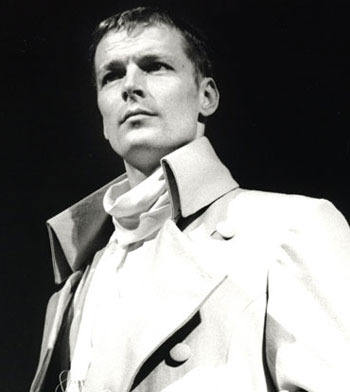
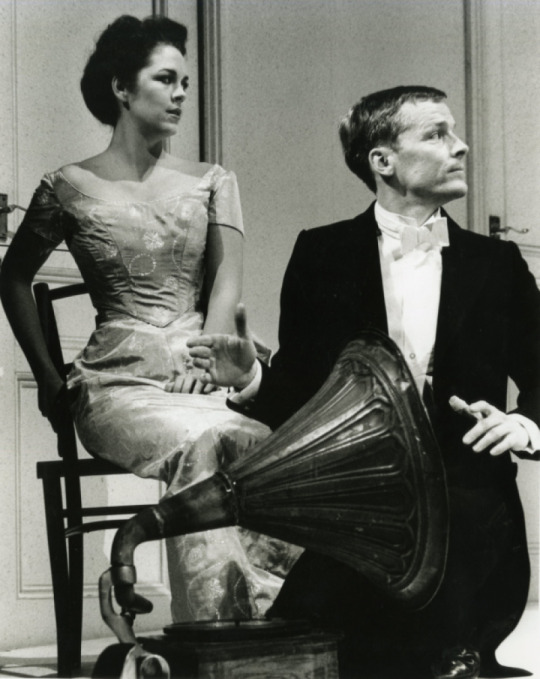




*(The Charleson Awards were established in memory of Ian Charleson, who died at 40 from Aids while playing Hamlet at the National Theatre in 1989)
- Iain Glen is a rampaging prince, quixotic, technically sound, tense as a coiled spring, funny. ‘To be, or not to be’ results from throwing himself against the white walls, an air of trembling unpredictability is beautifully conveyed throughout. ‘Oh, what a rogue and peasants slave’ is blindingly powerful. My life is drawn in angrily modern post Gielgud Hamlets: David Warner, Nicol Williams, Visotsky, Jonathon Price. Iain Glen is equal to them. He keeps good company. THE OBSERVER, Michael Coveney
- Paul Unwin’s riveting production reminded me more strongly than any I have ever seen that the Danish Court is riddled with secrecy. Politics is a form of hide and seek: everyone stealthily watches everyone else. Iain Glen’s Hamlet is a melancholic in the clinical sense: his impeccable breeding and essential good nature keep in check what might be an approaching breakdown. His vitriolic humour acts as a safety valve for a nagging instability, his boyish charm is deployed to placate and deceive a hostile and watchful world. Glen brings out Hamlet’s fatal self absorption: the way he cannot help observing himself and putting a moral price tag on every action and failure. He is a doomed boy. And his chill but touching calm at the end is that of a man who has finally understood the secrets behind the closed doors. The Sunday Times, John Peter
- This is an excellent production of Hamlet from the Bristol Old Vic. The director Paul Unwin and his designer Bunnie Christie have set the play in turn of the century Europe. Elsinore is a palace of claustrophobically white walls and numerous doors. All this is handled with a light touch, without drawing attention away from the play. Our first encounter with Hamlet shows him bottled up with rage and grief. Glen gives a gripping performance. The self-dramatising side of the character is tapped to the full by this talented actor. The Spectator, Christopher Edwards
**************************************************************************************************
The following though is my favorite review/article because it situates Iain Glen’s creation is time, in the spectrum of all renowned Hamlets.
How will Cumberbatch, TV’s Sherlock, solve the great mystery of Hamlet? by Michael Coveney - Aug 17, 2015
In 1987, three years before he died, the critic and venerable Shakespearean JC Trewin published a book of personal experience and reminiscence: Five and Eighty Hamlets. I’m thinking of supplying a second volume, under my own name, called Six and Fifty Hamlets, for that will be my total once Benedict Cumberbatch has opened at the Barbican.
There’s a JC and MC overlap of about 15 years: Trewin was a big fan of Derek Jacobi’s logical and graceful prince in 1977 and ended with less enthusiastic remarks about “the probing intelligence” of Michael Pennington in 1980 (both Jacobi and Pennington were 37 when they played the role; Cumberbatch is 39) and emotional pitch and distraction of Roger Rees in 1984 (post-Nickleby, Rees was 40, but an electric eel and ever-youthful).
I started as a reviewer in 1972 with three Hamlets on the trot: the outrageous Charles Marowitz collage, which treats Hamlet as a creep and Ophelia as a demented tart, and makes exemplary, equally unattractive polar opposites of Laertes and Fortinbras; a noble, stately Keith Michell (with a frantic Polonius by Ron Moody) at the Bankside Globe, Sam Wanamaker’s early draft of the Shakespearean replica; and a 90-minute gymnastic exercise performed by a cast of eight in identical chain mail and black breeches at the Arts Theatre.
This gives an idea of how alterable and adaptable Hamlet has been, and continues to be. There are contestable readings between the Folios, any number of possible cuts, and there is no end of choice in emphasis. Trewin once wrote a programme note for a student production directed by Jonathan Miller in which he said that the first scene on the battlements (“Who’s there?”) was the most exciting in world drama; the scene was cut.
And as Steven Berkoff pointed out in his appropriately immodestly titled book I Am Hamlet (1989), Hamlet doesn’t exist in the way Macbeth, or Coriolanus, exists; when you play Hamlet, he becomes you, not the other way round. Hamlet, said Hazlitt, is as real as our own thoughts.
Which is why my three favourite Hamlets are all so different from each other, and attractive because of the personality of the actor who’s provided the mould for the Hamlet jelly: my first, pre-critical-days Hamlet, David Warner (1965) at the Royal Shakespeare Company, was a lank and indolently charismatic student in a long red scarf, exact contemporary of David Halliwell’s Malcolm Scrawdyke, and two years before students were literally revolting in Paris and London; then Alan Cumming (1993) with English Touring Theatre, notably quick, mercurial and very funny, with a detachable doublet and hose, black Lycra pants and bovver boots, definitely (then) the glass of fashion, a graceful gender-bender like Brett Anderson of indie band Suede; and, at last, Michael Sheen (2011) at the Young Vic, a vivid and overreaching fantasist in a psychiatric institution (“Denmark’s a prison”), where every actor “plays” his part.
These three actors – Warner, Cumming, Sheen – occupy what might be termed the radical, alternative tradition of Hamlets, whereas the authoritative, graceful nobility of Jacobi belongs to the Forbes Robertson/John Gielgud line of high-ranking top drawer ‘star’ turns, a dying species and last represented, sourly but magnificently, by Ralph Fiennes (1995) in the gilded popular palace of the Hackney Empire. Fiennes, like Cumberbatch, has the sort of voice you might expect a non-radical, traditional Hamlet to possess.
But if you listen to Gielgud on tape, you soon realise he wasn’t ‘old school’ at all. He must have been as modern, at the time, as Noel Coward. Gielgud is never ‘intoned’ or overtly posh, he’s quicksilver, supple, intellectually alert. I saw him deliver the “Oh what a rogue and peasant slave” soliloquy on the night the National left the Old Vic (February 28, 1976); he had played the role more than 500 times, and not for 37 years, but it was as fresh, brilliant and compelling as if he had been making it up on the spot.
Ben Kingsley, too, in 1975, was a fiercely intelligent Royal Shakespeare Company Hamlet, and I saw much of that physical and mental power in David Tennant’s, also for the RSC in 2008, with an added pinch of mischief and irony. There’s another tradition, too, of angry Hamlets: Nicol Williamson in 1969, a scowling, ferocious demon; Jonathan Pryce at the Royal Court in 1980, possessed by the ghost of his father and spewing his lines, too, before finding Yorick’s skull in a cabinet of bones, an ossuary of Osrics; and a sourpuss Christopher Ecclestone (2002), spiritually constipated, moody as a moose with a migraine, at the West Yorkshire Playhouse.
One Hamlet who had a little of all these different attributes – funny, quixotic, powerful, unhappy, clever and genuinely heroic – was Iain Glen (1991) at the Bristol Old Vic, and I can imagine Cumberbatch developing along similar lines. He, like so many modern Hamlets, is pushing 40 – as was Jude Law (2009), hoary-voiced in the West End – yet when Trevor Nunn cast Ben Whishaw (2004) straight from RADA, aged 23, petulant and precocious, at the Old Vic, he looked like a 16-year-old, and too young for what he was saying. It’s like the reverse of King Lear, where you have to be younger to play older with any truth or vigour.
Michael Billington’s top Hamlet remains Michael Redgrave, aged 50, in 1958, as he recounts in his brilliant new book, The 101 Greatest Plays (seven of the 101 are by Shakespeare); Hamlet, he says, more than any other play, alters according to time as well as place.
So, Yuri Lyubimov’s great Cold War Hamlet, the prince played by the dissident poet Vladimir Visotsky, was primarily about surveillance, the action played on either side of an endlessly moving hessian and woollen wall. And in Belgrade in 1980, shortly after the death of Tito, the play became a statement of anxiety about the succession.
There’s a mystery to Hamlet that not even Sherlock Holmes could solve, though Cumberbatch will no doubt try his darndest – even if he finds his Watson at the Barbican (Leo Bill is playing Horatio) more of a hindrance than a help; there are, after all, more things in heaven and earth than are dreamt of in his friend’s philosophy.
*************************************************************************************************
Oh! Did I say that we were never going to see Iain Glen in the skin of the great Dane? Tsk. How silly of me. Meet IG’s Hamlet in Tom Stoppard’s postmodern theatrical whimsy ROSENCRANTZ AND GUILDENSTERN ARE DEAD, shot the year before the Bristol play.
Though almost surreal and most often funny as the film follows the Pulp Fiction-like misadventures of two forgettable Shakespearian characters, crossing paths with other more or less fortunate characters, their time with Hamlet makes us privy to the Dane as we never quite see him in the Bard’s play... but for one memorable scene, in which Iain Glen absolutely nails it, emoting the famous “To be or not to be” which you see tortures his soul, brings tears to his eyes and contorts his mouth; the moment made all the more memorable by the fact that it is a silent scene. You never hear him utter the famous line, but you see the words leave his lips and feel them mark your soul.
I’m kinda telling myself that it’s 1991 and I’m sitting in the Old Vic, in Bristol, not London. Not yet.
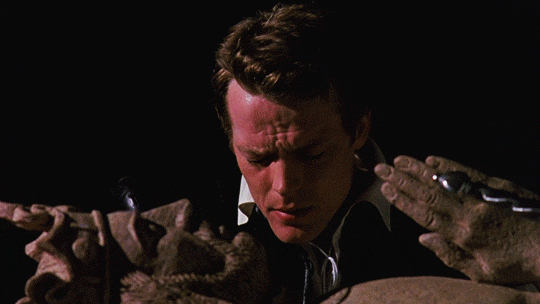
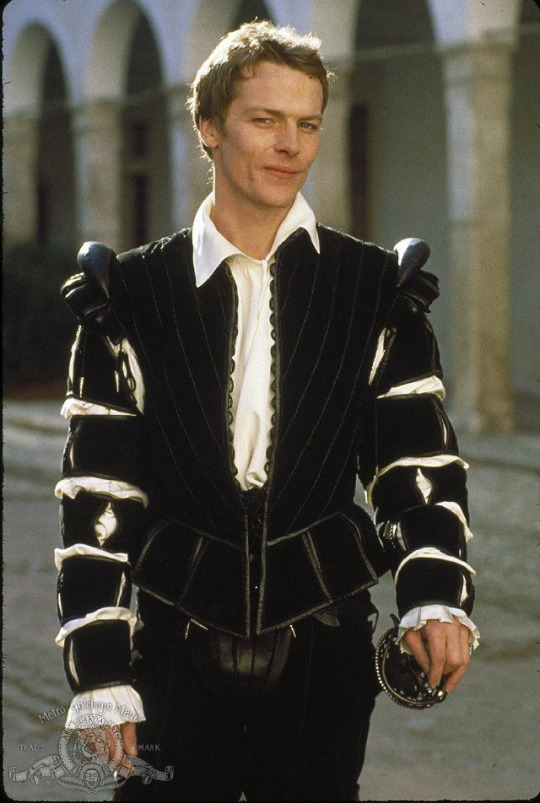



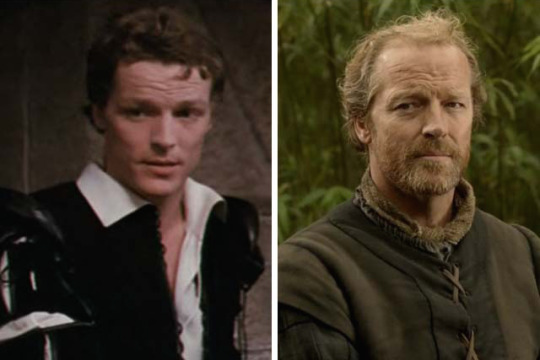
36 notes
·
View notes
Photo



An unexpected eBay find. The programme for The Witch of Edmonton, performed by students at the Bristol Old Vic Theatre School in June 1984.
30 notes
·
View notes
Text

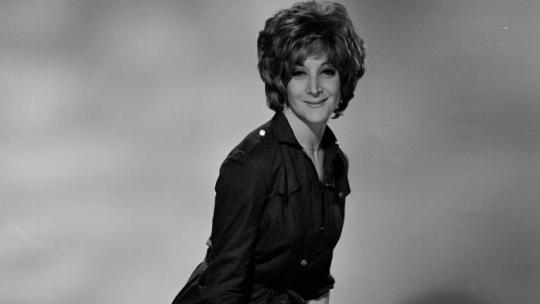
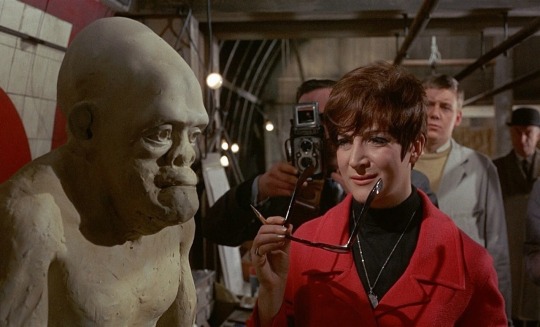
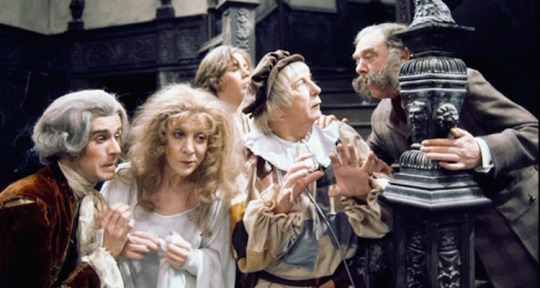


RIP Sheila Steafel (26.5.1935 - 23.8.2019)
I recently started watching Granada's 70's children's series The Ghosts Of Motley Hall (1976 - 1978), as certain mutuals will attest, and found it suddenly became compulsive viewing - so much so that I watched all three series in a little over a week. It's with some sadness, then, that I read of the passing of Motley Hall star Sheila Steafel during that very week.
Born Sheila Frances Steafel in Johannesburg, in 1935, to English emigrees Harold and Eda, Sheila was introduced to the stage at an early age. Her father directed and acted in amateur theatre productions, whilst her mother was a gifted pianist, and her childhood was one of music and culture: both parents were involved in organising a choir at the local synagogue, which Sheila sang for. At school she got into trouble for writing a risqué pantomime - already she was making waves as a comic performer.
In 1953, Steafel abandoned her university education in South Africa and moved to Britain. She applied to study at RADA, and completed a preparatory term before being told that her 'unusual' looks and mannerisms would be a hinderence for a young performer; she was advised to wait until her thirties and try to become a character actor. She refused to give up on her career, however, instead enrolling in the renowned Webber Douglas Academy, winning the Margaret Rutherford award for comedy.
Roles on television soon followed, with guest spots on the likes of No Hiding Place (1959), and a supporting role in the 1960 adaptation of H. G. Wells' Kipps. She fared even better onstage, taking over the role of Barbara opposite Tom Courtenay in Lindsay Anderson's celebrated production of Billy Liar in 1961. There were some more genre credits - episodes of The Odd Man (1962) and it's sequel It's Dark Outside (1965), Sergeant Cork (1963) and Danger Man (1966), as well as small film roles in the likes of Daleks' Invasion Earth 2150 A.D. (1966), Quatermass And The Pit (1967) and Otley (1968). By the middle of the decade, however, Steafel was settling happily into the genre for which she had always seemed destined: comedy.
Over the next decade or so, Sheila became the first choice of support for almost every major comedian on British television. The list of shows she worked on makes for an enviable CV, and she was variously comic foil, stooge, straight-woman and love interest to anyone who was anyone in TV comedy. She worked with Peter Cook and Dudley Moore, Frankie Howerd, Eric Sykes and Spike Milligan; she was in every episode of Bernard Cribbins' 1970 sketch show, appeared alongside Tommy Cooper, The Goodies, Kenny Everett and Roy Hudd. She was part of the regular cast of the seminal satirical series That Was The Week That Was (1966 - 1967), playing against John Cleese and Ronnies Barker and Corbett, all at the start of their long careers. The 'unusual' looks that had seen her dropped from RADA did not, seemingly, prevent her from becoming an almost ubiquitous face on British comic television throughout the 1960s and 1970s - it didn't hurt, either, that she had impeccable comic timing and a versatility which meant she could turn her hand to almost any role.
In 1976, Sheila was cast in the role which, for many viewers, she would be best remembered. Richard Carpenter, the actor turned scriptwriter, had already made his name with the children's series Catweazle (1970 - 1971) when he started work on The Ghosts Of Motley Hall. Unlike his earlier work, Motley was more of an ensemble piece, following the misadventures of a group of spirits tied to a former stately home as they attempt to prevent it's sale or demolition. There were to be five ghosts in all, representing a range of eras; from Arthur English's Elizabethan jester Bodkin, through to Freddie Jones' 19th century General, Sir George Uproar. The cast was completed with Nicholas Le Prevost, as Jones' dim ancestor Sir Francis Uproar, and Sean Flanagan as young stable boy Matt. To round out the show, Carpenter needed a female character - so Steafel was cast as The White Lady, the spirit of a long-forgotten and mysterious woman whose true identity is a mystery to everyone, including herself.
I was a little wary, going into the series: although I have enjoyed quite a lot of the classic children's television I have watched as an adult, it is undeniably a mixed bag. I needn't have worried, because Motley is that rarest of things - a show that truly appeals to the whole family. It's fun and it's silly, and there's just enough excitement to cater to a young audience, but it's also filled with subtle comedy, jokes and references for the older viewer, and moments of surprising pathos. At it's heart, it is held together by five superb performances from the central cast; Freddie Jones is having just the time of his life as the loud, blustering blowhard Sir George, Arthur English is gently good humoured as the fool whose jokes have aged as badly as the Hall, and Le Prevost reveals a gift for subtle physical movements that make his moments of confusion or distraction much funnier. As a young performer up against four seasoned professionals, Flanagan equips himself very well, and makes for one of the more relatable and likeable teen leads in this kind of programme. And, floating between them, Steafel creates one of her most memorable and endearing characters. Particularly nice is the unique relationship she has with each of the others - she is the ghost best suited to calming Sir George from his pompous rages, or curtailing Bodkin's comic performances when the others have had enough - and especially in her relationship with Sir Francis. It isn't outright stated, but the two spirits are clearly close friends: whenever there is a dispute, they side together; whenever the ghosts must search the hall for an intruder or lost item, it is Francis and the White Lady who team up first; if ever one of the others is rude or ungentlemanly in her presence, Francis immediately springs to defend her honour. Most adorably, they are shown more than once to spend time together relaxing without the others - in an early episode they discover a television together, and end up practicing yoga as a duo. It's a lovely, deep, subtle friendship that is never brought centre-stage but plays itself out in the background of the main plots.
Like her earlier comedy work, Motley allowed Steafel to try her hand at new things and to stretch her performing skills - the White Lady gets some wonderful moments, and a real range of storylines. There are moments of sorrow, concerning her lost identity and feelings of isolation; fury, when the business of the other ghosts interferes with her practice of wailing on the stairs; and much comedy, particularly from the discovery late in series one that she is the only spirit that can be seen by Gudgin - the hall's caretaker, played by sitcom stalwart Peter Sallis. This revelation leads to an ongoing element in the series, as the White Lady brings messages to Gudgin and notifies him of any complaints among her fellow ghosts - her insistence that the caretaker is slowly becoming accustomed to her presence, and in fact even becoming fond of her, in the face of his obvious and continuing terror, is one of the sweetest things about her character.
Like the other four key cast members, Sheila appeared in all twenty episodes of The Ghosts Of Motley Hall. Afterwards, she continued to make television appearances, but spread her wings wider - she became a regular voice on radio, and returned to the stage, making memorable appearances in the 1985 RSC production of The Merry Wives of Windsor and as Meg in the 2006 revival of Pinter's The Birthday Party for the Bristol Old Vic. She took numerous one-woman shows to the Edinburgh Festival, and her dry wit and sparkling personality made her a regular booking on all manner of panel shows. She continued working into her later years, making numerous appearances on TV soaps like Holby City and Doctors, whilst also turning her hand to writing. Her first book was an autobiography, When Harry Met Sheila, published in 2010 - in it she recounted her long career, as well as the story of her marriage to Harry H. Corbett. The two had met as young performers and married in 1958, divorcing some six years later. Sheila didn't remarry, but had several relationships and many close friends and colleagues throughout her long and distinguished career. In 2012 she published another book, a collection of short stories based on real encounters she had in her long life. With wry good humour, she titled it Bastards. Sheila Steafel leaves a legacy of laughter and entertainment, and a litany of comic performances that would be the envy of any young actor.
#Sheila steafel#Rip#in memoriam#Death ment#obituary#Another lonnnng post sorry#These things get away from me#I don't know what rada were talking about tbh#I think she was very beautiful#Not that that is even important anyway!#The ghosts of motley hall#Mr. Rose#It's dark outside#danger man#That was the week that was#Tw3#No hiding place#Sergeant cork#Billy liar#Quatermass and the pit#bernard cribbins#Pete and dud#Frankie Howerd#kenny everett#Tommy Cooper#classic tv#character actors
22 notes
·
View notes
Text
Prince Harry called Dame Helen Mirren 'GRANNY' when they first met - 'I was INSULTED!' - Express
New Post has been published on https://harryandmeghan.xyz/prince-harry-called-dame-helen-mirren-granny-when-they-first-met-i-was-insulted-express/
Prince Harry called Dame Helen Mirren 'GRANNY' when they first met - 'I was INSULTED!' - Express


The Duke of Sussex, who is known for his comical side, teased Dame Helen at an awards ceremony saying “granny is here” as the two bumped into each other. However, the actress joked she felt “rather insulted” by the comment. Helen Mirren is known for playing Queen Elizabeth in the 2006 British fictional drama film, depicting the Royal Family’s bereavement after the death of Princess Diana.
Despite that, the actor teased that she felt Harry had crossed the line.
Speaking to Good Morning Britain, she said: “Harry and William, have mentioned playing the Queen to me and they have been very funny and very cool about it.
“I think Harry once at an awards ceremony said, ‘And granny is here’ and I was rather insulted by that. I mean, really!”
Helen Mirren praised Harry’s wife, Meghan Markle, saying how she greatly “admired” the Duchess for embodying traits of “elegance and discipline” after being thrust into the spotlight.
She added: “I think right from the moment that relationship was revealed she conducted herself with incredible self-restraint, elegance, discipline and simplicity and humanity.
“I was an admirer. It’s an incredibly difficult life to lead, talk about pressure. I think she is doing it with great elegance.”
Dame Helen helped launch GMB Prince’s Trust Mentor Of The Year award and praised the charity for being a great way to help young and vulnerable people get their lives on track.
She said: “A lot of kids don’t have the advantage of good parenting, and I did have good parenting.
“But even with good parenting when you are out in the world and you’re intimidated by the challenges of the professional world.
“I had a wonderful teacher who guided me towards the National Youth Theatre and I then had a co-actor, Sir Ian Richardson, who was a wonderful mentor for me and believed in me when I was a young, very insecure actress.
“He was a brilliant, brilliant actor and he was just so incredibly kind.”
The actor added: “If you have that kindness, that encouragement, I would encourage any, older person in any workplace always be encouraging towards young people, always support them.”
Meghan and Harry stepped out today in the blistering snow for a visit to the Bristol Old Vic theatre, which is undergoing a £26million restoration.
The royals brought a touch of warmth to an otherwise chilly day, greeting dozens of fans who lined up outside the building in hopes to catch a glimpse of the couple.
Meghan looked stunning in a printed Oscar de la Renta dress, and wore her hair in elegant loose waves.
The Duke and Duchess took part in a workshop attended by local children as part of Bristol Old Vic’s outreach programme.
Meghan delighted the youngsters, joking about with them as the royals unveiled a plaque.
The royals then headed to charity One25, which aims to help get sex workers of the streets.
Meghan came up with the idea of leaving encouraging messages for the sex workers, by writing words on bananas such as “You are strong”, “You are loved”, “You are brave” and “You are special”.
The Duke and Duchess then visited the Empire Fighting Chance, a charity that uses boxing to support children struggling at school to prevent them from drifting into unemployment.
0 notes
Text
A Very Theatrical Q&A
When Maggie Harcourt’s talented set-designer pal, Clare Thornthwaite, designed and built and, well, truly brought to life, the Theatrical model box from Maggie’s most recent book, we could hardly hide our excitement. We wanted more and we wanted details! Luckily for us Clare and Maggie got together revealed all…

CLARE: We met on a theatre production course at the Theatre Royal Bath a couple of years ago. Was that inspiration for Theatrical, or were you already working on it and the course was part of your research?
MAGGIE: That course really was where Theatrical started, because over that week we had to learn everything about what it takes to produce a show for a professional theatre. I'd always been interested in how theatres work (which was why I was on the course!) but having the chance to see so much of what happens in the background - even before you actually get backstage - really made me want to write about theatres. There was something about the fact we were all getting to hang out backstage and go in and out of the stage door to the studio theatre every day while a show was running through its dress rehearsals in the main theatre that was so special: I wanted to try and put some of that feeling into a book. And when we had the day learning about stage management... that was it. I started hearing Hope in my head right after that.
CLARE: I love how the model box is like a character within the book. Why did you decide to make that a part of the story?
MAGGIE: It was one of those things that I didn't plan at first, but which grew with the story. To begin with, the fact Hope has a scale model of an auditorium in her room was really just a way of showing how seriously she takes her dream to work as a professional stage manager – but then, the model of the Earl's stage that sits in the production office of the theatre (and which the creative team and designers would have used to help them visualise how the show would look on-stage) became a way for Luke to send messages to her, letting her know how he felt without having to actually say it. To everyone else in the theatre, the model is just part of the furniture, or one of the tools they use every day, but to Hope it's really special because it's a symbol of everything she wants. Including Luke...
CLARE: You really capture the magic of the theatre and the fun and drama that goes on behind the scenes. It felt so authentic: how did you go about making sure the backstage world of your theatre seemed real?
MAGGIE: A lot of research! Quite a lot of my notes from the Theatre Royal Bath course went into it, and I read a couple of the stage management texts we'd been told about on the course too. Something that makes me very happy is that after I was finished with them, they got to fulfil their theatre destiny when I gave them to a student just starting out on the stage management course at the Bristol Old Vic Theatre School. As well as that, I got in touch with the lovely backstage team at the Bristol Old Vic itself and they let me visit and poke around for a morning, including all the way up on the fly floor above the stage. The Bristol Old Vic is a big part of the Earl's, really - there's bits of it built into the DNA of the Earl's, the theatre I invented for the book, along with the Theatre Royal Bath, the Old Vic in London and probably every theatre I've ever been in. But the feel and atmosphere of the backstage areas definitely came from the Bristol Old Vic and the Theatre Royal Bath. Apart from that, it was a lot of reading and daydreaming: I subscribed to The Stage and read it every week - especially the columns, and Jess Gow's articles about stage management; I read reviews of just about every big show that opened, just as background. The 'behind the scenes' programme from Harry Potter & the Cursed Child was super-helpful because it talked so much about the process of building a show from the very beginning, and there's an amazing photo book called Unseen London which has an entire backstage section. I felt like if I could picture the theatre in my head, from the corridors under the stage all the way up to the very top of the auditorium and beyond to the studio at the very top of the building, hopefully I could make it real enough for everyone else to see it too: something your amazing model box makes even easier!

Clare Thornthwaite building a model box for "Our Ladies of Perpetual Succour".
MAGGIE: First of all, I have to tell you how much I LOVE the Theatrical model box you built. How do you even start making something like that, and how do you capture the spirit of a whole theatre in something so small?
CLARE: I’m so pleased you like the model box, I really enjoyed making it too! The best place to start is with the plans. I contacted the Bristol Old Vic theatre who very kindly sent me technical drawings of their stage. In theatre design, we generally work to the scale 1:25 which means for every 1cm on the model equals 25cm on the real stage. The model I made for you is at a smaller scale of 1:50 so the figures are only 35mm high. It can be quite fiddly working on something so small, but the results are always rewarding and super cute! The black box is made from foam board so it is lightweight and easy to transport and the details on the stage are made from thinner pieces of card. I took inspiration from the beautiful book cover design, printing out the letters and hanging them with fine pieces of wire. The trees and hearts are cut out by hand with a sharp scalpel knife and coloured using acrylic paints and chalk pastels. It’s all held together with plenty of super glue! Traditionally the model box is a tool for everyone on the production. For the designer, the great thing is that you can see what is working and change the elements that don’t look right. The director can make decisions on where the action will take place. The actors use it to see where their entrances and exits will be and what obstacles they may need to negotiate, like steps or big pieces of furniture for example. A production manager will use the model box to work out a budget for how much things will cost to make and the set builders can work out how to actually construct the set. Most of all it helps everyone visualise how the show will hopefully look in the end.
MAGGIE: What drew you to the world of theatre, and what do you love most about it?
CLARE: I imagine like a lot of people, one of my earliest memories of the theatre is going to see a pantomime at Christmas as a child with my family. I’ve always loved dressing up and won several fancy dress competitions when I was younger so have always had an interest in costume design. I went on to university to study Interior Design which is very similar to set design, which is also where I learned how to make scale models. For me the theatre is pure escapism, I enjoy getting totally lost in a different world and being sucked into someone else's story for a couple of hours. There is something magical about the action being performed live right there in front of you and with the energy from the audience, it all adds to the unique atmosphere of the theatre. Working behind the scenes and being part of the team that makes the magic happen is pretty special. It is a very collaborative process and challenges my creativity in new and exciting ways.
MAGGIE: What would your dream job be? If you could work on designing a new production of ANY show - whether it's a musical, a play, an opera, a ballet - what would you choose and why?
CLARE: My dream job would be to design something for the Olivier Stage at the National Theatre. Under the stage is a five storey high drum revolve which gives the designer unlimited possibilities. In 2014, I saw the NT’s production of Treasure Island designed by Lizzie Clachan; when the full-size pirate ship emerged from the stage it absolutely blew my mind! I’d love to create something so amazing that it wows the audience and leaves them speechless! If I could design any show it would have to be an Agatha Christie mystery, And Then There Were None maybe? Having the power to keep the audience guessing works so well that Christie’s play The Mousetrap is the longest running play in the world. I love how audiences continue to keep the ending a secret night after night. I also really like the fashion and interior styles of the 1920s and ‘30s so this would fit with the period and would be a lovely era to design for.
If you’d love to hear Maggie talk more about the theatre world, she’s in conversation with Amber Massie-Blomfield at the Theatre Royal Bath on Jan 17th, about her brilliant book “Twenty Theatres to See Before You Die”. Maggie also promised to bring along the Theatrical model box!
#Theatrical#Usborne YA#UKYA#Maggie Harcourt#YA Shelfies#Usborne Shelfies#Amber-Massie-Blomfield#theatre royal bath#backstage#Twenty Theatres to See Before You Die#Clare Thornthwaite
0 notes
Photo


Programmes of Bristol Old Vic
The Matchmaker, Ondine by Jean Giraudoux, Volpone, The Skin of Our Teeth, The Empty Chair by Peter Ustinov, Major Barbara(2), Dick Whittington, Lamp at Midnight, The Queen and the Rebels, The Slave of Truth, The Recruiting Officer by George Farquhar, Othello, Sleeping Beauty, Great Expectations, Oh! my Papa!, Look Back in Anger, Romanoff and Juliet, A Midsummer Night’s Dream, Sodom and Gomorrah, Waiting for Godot, Ali Baba and the Forty Thieves, Man and Superman, Hamlet, The Pier, Amphitryon 38
***
私はBristol Old Vic時代のPeter O'Tooleと彼の舞台に強い関心があります。でも、Bristol Old Vic時代の舞台写真や記事はあまり多くはないように思います。少なくとも私は見つけられないでいます。私はそれがとても残念です。だから、せめて舞台のprogrammeを集めたい、集めようと思い、機会あれば手に入れてきました。今回、23冊セットでauctionに出ました。ただ、これまでに入手したものとダブっているものがあり、少し迷いましたが、思い切って入札し、落札しました。
上が今までの分、下が今回手に入ったものです。星のマークが付いているのがダブったprogramme。つまり、2冊になったというわけです。本当は一冊一冊ちゃんと詳細を添えて投稿したいのですが、今あまり時間的余裕がありません。だから、とりあえずこれだけ集まった、という意味でズラリと並べて投稿しておくことにしました。とても個人的な記録です。
それと、気になるのが一冊あります。一番下の右端ですが、変だなと思って確認しましたところ、この舞台には出演していません。どうやら出品者さんが勘違いしてしまったようです。せっかくなので一緒に写しました。ややこしくてすみません。
2 notes
·
View notes
Text
Three Shows and a Dramaturgy: Tim Marriot @ Edfringe
A Warning From History – Mengele
As the Labour Party argues over the definition of anti-Semitism* and the Israeli government approves a Jewish Nation State**, divisions deepen and boundaries blur.
All across Europe and the USA extremist views advance and the Far Right begins to creep into government.
Against this contemporary background, Smokescreen Productions offers a warning from history at the Edinburgh Festival Fringe.
Mengele takes us back to a beach in Brazil in 1979 when a drowning man is washed up on a beach where he meets a mysterious woman.
The play imagines the notorious doctor of Auschwitz confronted by the woman he assumes has saved him.
vimeo
Mengele Trailer from Smokescreen Visuals Ltd on Vimeo.
Shell Shock Tackles Major Mental Health Issue Related Deaths of Veterans
Fringe Encore Winner and Best Solo Show, Adelaide Fringe 18
The Ministry of Defence has just admitted that it “does not hold information on the causes of death for all UK Armed Forces veterans”*.
This includes the growing numbers among our estimated 2.6 million former service men and women who take their own lives.
The multiple award-winning play Shell Shock,which is coming to the Edinburgh Festival Fringe on 11 August as part of the Army@TheFringe programme, tackles the mental health challenges faced by some veterans trying to return to civilian life.
All Change – Ivor’s Not Going Quietly
Ivor waits, his train of thought broken by his fragmented and decaying memory.
His daughter Lily packs a bag, preparing him for a “home”. But Ivor’s not going quietly. As fast as Lily packs, he unpacks...
Performed by sitcom veteran Tim Marriott with Stefanie Rossi as Lily, it’s a tale for our times, addressing the issues of failing memory and caring for an aging parent – something growing numbers of us can expect to face in years to come.
youtube
First of all, how do you define mental health? What does the term mean to you - do you have a social model of sanity, for example, or is it concerned with neural atypical conditions?
We are all happy to discuss our physical health… I wear a Fitbit tracker and will happily bore anyone to death about how many steps I have taken today, this week, this month… but there is a stigma around mental health that, in order to be truly healthy, we should address. Mental health therefore means to me exactly that – a healthy, balanced, exercised and fit mental state… or not.
I don’t think of mental health in terms of expected social norms, or psychosis, but more in terms of how I react to stress and pressure on a daily basis. There are neuroses, injuries, degenerative conditions, physical and mental traumas and imbalances covered by the very general term ‘mental health’, but on a day to day, the phrase makes me think of emotional and intellectual well being.
What areas of mental health are you looking at in the performance?
I am doing three shows at EdFringe that
can be seen to deal with different aspects of
mental health. Two established shows and one new one. ‘
Mengele’ exposes the mind of a narcissistic sociopath, ‘Shell Shock’ charts the descent through toxic masculinity into Post Traumatic Stress Disorder. The new show, ‘All Change’ is a deeply personal family story about living with dementia interpreted through a domestic and comedic setting.
In what ways do you hope that your play can help the audience to move forward in their understanding and actions towards a greater sense of mental good health?
In ‘All Change’, we use humour to bring the audience into the world of Ivor and his daughter Lily as she attempts to prepare him for life in a ‘home’. Her gentle handling of this irascible character says much about how we can respond to the condition and ease the confusion of the sufferer. Though the play also contains other complexities in that Lily has her own issues that she struggles to share with her father as his mind slips away. The play is not didactic, that is not our style, but hopes to at least provoke a conversation or two.
And given the high pressure nature of the Fringe, do you have any ideas about positive self-care during August in Edinburgh.
Performing three plays during the fringe will be a challenge and the level of involvement in each one, the emotional and physical demands of each role will make us vulnerable to anxiety and stress. Audience reaction and reviews can feel very personal and you can’t win ‘em all, so we need to be prepared to take the rough with the smooth.
As a reviewer myself, I try and take account of
this when offering a written response as I know what negative criticism can feel like and how destructive it can be to one’s mental health.
I will try and make myself and my company as resilient as possible by keeping physically fit, eating and sleeping well, keeping regular hours and avoiding too many late nights and alcohol!
Josef Mengele, known in the camp as “The Angel of Death”, escaped justice after WW2 and escaped to South America.
The woman challenges him to attempt to justify the unjustifiable and in so doing exposes the rhetoric of a sociopathic narcissist, echoing arguments we hear again today.
Created following advice from the Holocaust Educational Trust and endorsed by the Amud Aish Museum of New York, Mengele seeks to engage, educate and provoke conversations about the issues of today as much as of the past.
A short run at Edinburgh last year was followed by an award to take the play to New York as a Fringe Encore winner, then on to a sell out season at Adelaide Fringe 2018.
Inspired by the novel Right to Die, the play is written by Philip Wharam and Tim Marriott, who also performs it with Stefanie Rossi and Emma Wingrove.
Mengele, the play, is inspired by and written to acknowledge the chilling truth expressed by Auschwitz survivor Lydia Tischler who said: “all of us have the capacity to be sadistic and horrible to other people. The potential for destructiveness is in all of us.”Marriott says:“It is vital for us to understand such men as Mengele, to learn from history, to stop others like them from rising again.”
Adapted from Gulf War veteran Neil Blower Watkins’ autobiographical novel of the same name Shell Shocktells the story of long-serving soldier Tommy Atkins’ attempts to return to Civvy Street and his undiagnosed PTSD (post traumatic stress disorder).
The effects of PTSD amongst generations of ex-military and first responders in a social media driven society where we are constantly under pressure to live “happy and fulfilled” lives are huge.
Shell Shockwas adapted for the stage and is performed by BBC comedy veteran Tim Marriott (The Brittas Empire) and was created in association with military and mental health charities as a stigma reduction project for the military community and beyond. Earlier this year it was named Best Solo Show at the Adelaide Fringe.
The play is ultimately positive, offering hope and support, and is followed by informal interactive feedback sessions, or “Fire Circles”, where others are encouraged to share their own stories.
Marriott said:“PTSD can be a huge challenge for veterans. All too often the symptoms are repressed, unrecognised and often go untreated, especially in a culture defined by masculine grit. For generations we have taught our young men tobe embarrassed about their emotions and hide them, or avoid communicating them – unless in anger. This is now recognised as Toxic Masculinity.”
As Tommy shares his observations on the absurdities of the everyday with the audience, so the cracks in his military grit become apparent. As he represses his reactions to flashbacks, he rails at the world in increasing outrage. Nothing is safe. From post office queues to Ikea, computer games to ‘phone zombies, all feel the force of his frustration.
Listings Details
· Venue: Army @ The Fringe in association with Summerhall, Hepburn House Army Reserve Centre, East Claremont Street (Venue 210)
· Time: 17:30
· Duration: 60 mins
· Dates: 11, 12, 14-19, 21-25 August. Previews 10 August.
· Tickets: £9 to £12
· Bookings: https://festival18.summerhall.co.uk/book-tickets/
· Advisory: Contains strong language
Marriott said:“Hundreds of thousands of families across the UK are affected by dementia every year. It has an immense impact on the lives of everyone it touches and as time ticks on its something that any of us might eventually suffer. But whilst the personal tragedy of dementia is at the heart of All Change, it’s very much a play filled with humanity, warmth and humour.”
All Changebegan life as a devised project, inspired by the work of St Wilfrid’s Hospice, workshopped with drama students and scripted by Toby H Marriott, on an emerging writers course at the Bristol Old Vic Theatre. Based on personal experience, the play was then developed into a compact professional production, researched and developed in Bristol and at Brighton Fringe and now premiering at Edinburgh.
Alzheimer’s Society fact file
· There are 850,000 people with dementia in the UK, with numbers set to rise to over one million by 2025. This will soar to two million by 2051.
· Some 225,000 will develop dementia this year, that’s one every three minutes.
· One in six people over the age of 80 have dementia.
· Some 70% of people in care homes have dementia or severe memory problems.
There are over 40,000 people under 65 with dementia in the UK.
See https://www.alzheimers.org.uk
- Ends -
Listings Details
· Venue: Assembly George Square Theatre, The Box, EH8 9JZ (Venue 8)
· Time: 12:20
· Duration: 50 mins
· Dates: 9,11, 13, 15, 17, 19, 21, 23, 25, 27, 27 August. Previews 9 August
· Tickets: Previews £10 (£9); 11-27 August £12 (£11)
·
Marriottis best known for seven series of BBC TV's leisure centre sit-com The Brittas Empire, appearing in every episode as deputy manager, Gavin. Other TV credits include Allo Allo, Doctors, The Bill, An Actor's Life for Me, The Main Event, Luv and film credits include the forthcoming features The Real Thing, Love Type D and Revelation. He recently returned to the stage after an 18-year career break teaching English and drama. He is also appearing in two other Fringe 2018 productions, Shell Shockand All Change.
from the vileblog https://ift.tt/2AaKCfI
0 notes
Text
Here’s some news from Bristol…
Bristol’s new UNESCO City of Film status was officially launched in February at a celebration event at Watershed Media Centre.
The permanent status was awarded to Bristol by UNESCO (United Nations Educational, Scientific and Cultural Organisation) in November 2017, in recognition of its work as a world-leading film centre.
Bristol now stands alongside Bitola, Bradford, Busan, Galway, Łódź, Qingdao, Rome, Santos, Sofia, Sydney, Terrassa and Yamagata as an official City of Film.
Opened by Mayor of Bristol Marvin Rees, the event marked the official beginning of the City of Film programme and revealed more about what the new status means for Bristol.
Bristol’s five-time BAFTA-winning screenwriter Jack Thorne (Kiri, National Treasure, This is England ’86, ’88, ’90) said: “Bristol is my home city, so I’m biased, but I think it’s the most fascinating city in the country.
“There’s always something to do and experience; from the incredible outdoor spaces to the People’s Republic of Stokes Croft; from the brilliant Bristol Old Vic to the amazing carnival. I’m so proud it’s got this new City of Film status, it’s a place where stories should be told.”
Marvin Rees, Mayor of Bristol said: “As a UNESCO City of Film we have a unique chance to harness the power of a diverse industry and empower people to collaborate on combating inequality and break down the barriers to opportunity.
“Bristol is an outward looking city that understands the benefits of cooperating with partners across the world. Being part of the global UNESCO network with fellow creative cities means we’re expanding our ability to build international relationships and exciting new partnerships.
“Our goal is to ensure that those relationships directly benefit all communities across the city and help establish opportunities to support filmmaking talent, education, training and employment, whilst also widening cultural participation and engagement for our film audiences.”
Mark Cosgrove, Watershed Cinema Curator and Film Hub South West & West Midlands Chair said: “The UNESCO City of Film award is fantastic recognition of the rich film culture in Bristol and of the vital role film plays in the creative life of the city. Since 1982 Watershed has been presenting and celebrating the diversity of world cinemas.
“Audiences continue to be passionate and enthusiastic- and this passion and enthusiasm I am sure contributed to the UNESCO recognition. We very much look forward to working with partners across the city to develop local talent, production and audiences and to promote Bristol as a unique City of Film destination.”
Four overarching priorities will guide the first four years of activity. These are:
Film Production: enhancing Bristol’s reputation as a dynamic creative film hub, attracting and supporting TV and film production and inward investment
Film Culture: broadening engagement with Bristol cinema-goers through screen heritage projects and festivals, attracting visitors to the city and increasing screen tourism
Film Learning: unlocking talent, improving skills and increasing cultural capital by widening participation, engaging with schools and higher education providers
Reducing Inequalities: removing barriers and promoting inclusivity, using film as a tool to broaden learning and community engagement, inspire creativity and harness the potential of Bristol’s dynamic multiculturality
As well as showcasing existing successful film projects that helped Bristol achieve its UNESCO status, the event also previewed a selection of City of Film projects and collaborations in development:
A new Media Production Diploma at The Bottle Yard Studios for 16-19 yr olds, delivered by education provider Boomsatsuma
Bringing together existing city film and music initiatives in order to broaden content and audience participation.
Supporting and developing Film our City, a competition which invites Bristol’s young filmmaking talent to capture the diversity and dynamism of Bristol on screen
Bristol is home to world-leading media. Aardman Animations set up studios in Bristol in 1976, finding fame with Wallace and Gromit, Chicken Run, Shaun the Sheep, and more recently Early Man, which opened in UK cinemas on 26 January 2018.
BBC Bristol produces globally recognised radio, drama, factual and wildlife television, and the city is home to the largest production facility in the West of England, The Bottle Yard Studios, whose productions include Poldark, Broadchurch, and Wolf Hall. BBC Bristol also houses the globally significant Natural History Unit, spawning ‘Green Hollywood’, the world’s largest concentration of firms producing wildlife content.
With 11 community-driven international festivals dedicated to film annually, 10 cinemas, and 2 major universities (University of the West of England and University of Bristol) providing 28 film related degrees, Bristol will play a central role in this global network of like-minded cities.
Bristol City of Film is led by Bristol City Council, Bristol Film Office, UWE Bristol, University of Bristol, Screenology, Destination Bristol and The Bottle Yard Studios. City partners working together to develop City of Film projects include Watershed, Aardman Animations, Icon Films, Knowle West Media Centre, Calling The Shots, BBC Bristol, Slapstick Festival, Encounters Festival, Bristol Festivals, BFI SWWM Film Hub, Boomsatsuma, Bath Film Office, Afrika Eye Festival, We the Curious, Royal Television Society Bristol, Ujima Radio, Wildscreen Festival and many more.
Created in 2004, the UNESCO Creative Cities Network is a network of creative cities working together towards a common mission for cultural diversity and sustainable urban development.
The Creative Cities Network is currently formed by 116 Members from 54 countries covering seven creative fields: Crafts & Folk Art, Design, Film, Gastronomy, Literature, Music and Media Arts.
Bristol City of Film | Facebook | Twitter: @BristolFilmCity
(from a press release)
Bristol film sector gathers to launch Bristol’s new Unesco City of Film status Here's some news from Bristol… Bristol’s new UNESCO City of Film status was officially launched in February at a celebration event at Watershed Media Centre.
0 notes
Link
Nadia Clifford (Jane Eyre) NT Jane Eyre Tour 2017. Photo by BrinkhoffMögenburg
The on-stage rake is steeper than usual in this stage adaptation of Jane Eyre, at an angle I’ve not personally seen at the National Theatre since The Curious Incident of the Dog in the Night-Time. But it seems as though the set is incomplete, with wooden structures and ladders, as though Thornfield Hall, or the Lowood Institution for that matter, was still at the framing stage of construction. Aside from the decent performances from a well-drilled cast, it is only through some decent lighting (Aideen Malone) that there is ever a real sense of the gloomy nature of the place, as per the descriptions in Charlotte Brontë’s famed novel.
I was interested to discover that the show in its original form at Bristol Old Vic in 2014 was in two parts – that is, four acts in total, rather like Harry Potter and the Cursed Child. Having seen the truncated one part, two act production it now is, I suspect the longer version must have been dramaturgically more complete. Here, although it is a largely faithful rendering of the novel, covering all the salient points and then some, this production has a habit of suddenly jumping from one scene to the next. With only rudimentary scene changes, it can feel disjointed, even disorienting, as some effort is required to establish at the start of each new scene whether the narrative is now in a different location to the scene before. Further, quite how much time, story-wise, has passed between the end of one scene and the beginning of the next is not always clear.
Despite a steady pace, then, and a three-hour plus running time, it still came across as somewhat hurried. That is better, I suppose, than a production that is too much of a slog. A live on stage band (in the alphabetical order given in the show’s programme, Matthew Churcher, Alex Heane and David Ridley) add some atmosphere to proceedings, supplemented well by the vocals of Melanie Marshall, who also plays Bertha Mason, the first wife of Mr Rochester (a suitably dulcet-toned Tim Delap). The National Theatre seems to like Gnarls Barkley’s chart-topping song ‘Crazy’, having previously used a version of it in their 2011 production of The Comedy of Errors. I won’t give it all away, but suffice to say it isn’t about or used against the mentally unstable Mason.
The title character, played by Nadia Clifford, is always on stage, and her costume changes are thus performed with the audience looking on. Paul Mundell’s Pilot, a dog, didn’t quite hit the spot with everyone – some in the opening night audience chortled while others were distinctly unimpressed – though as a performance, the animal movements and sounds were as authentic as they could reasonably be. Unfortunately, at least from my vantage point, the sound levels between the music, whether it was live or recorded, and the performers was not always perfect, and the odd lyric was missed.
Familiarity does not always breed contempt. Despite knowing what was going to happen, even if I had no idea how precisely it would be staged, I retained a genuine interest in the show. There were moments of humour, too. Whether they were intentional or not is another matter. A toilet break during a long journey went down a hoot with the audience, though my highlight was the rather absurd use of modern-day energy saving lightbulbs as lanterns in a Victorian setting. An instance of both colour and gender blind-casting takes place in Evelyn Miller’s St John. Miller’s mannerisms and physicality, which even extended to manspreading, were impressive.
It took a little while for the show to grow on me, but it nonetheless proved an intriguing and intelligent production.
Review by Chris Omaweng
Jane Eyre
Following a critically acclaimed season at the National Theatre and a UK tour, Jane Eyre returns this September.
The classic story of the trailblazing Jane is as inspiring as ever. This bold and dynamic production uncovers one woman’s fight for freedom and fulfilment on her own terms.
Jane Eyre’s spirited heroine faces life’s obstacles head-on, surviving poverty, injustice and the discovery of bitter betrayal before taking the ultimate decision to follow her heart.
Jane Eyre
A co-production with Bristol Old Vic based on the novel by Charlotte Brontë devised by the original company
Running Time: 3 hours inc interval
Listings information
Jane Eyre
Tuesday 26th September – Saturday 21st October 2017
National Theatre, Lyttelton Theatre
South Bank, London, SE1 9PX
http://ift.tt/2hOiLsD LondonTheatre1.com
0 notes
Link
Following the brilliant performance of Mike Bartlett’s ‘13′ there’s a great programme of events coming up in May, from our colleagues at Bristol Old Vic Theatre School.
0 notes
Text
Meghan Makes Touching Gesture as the Sussexes Visit Snowy Bristol
New Post has been published on https://harryandmeghan.xyz/meghan-makes-touching-gesture-as-the-sussexes-visit-snowy-bristol/
Meghan Makes Touching Gesture as the Sussexes Visit Snowy Bristol
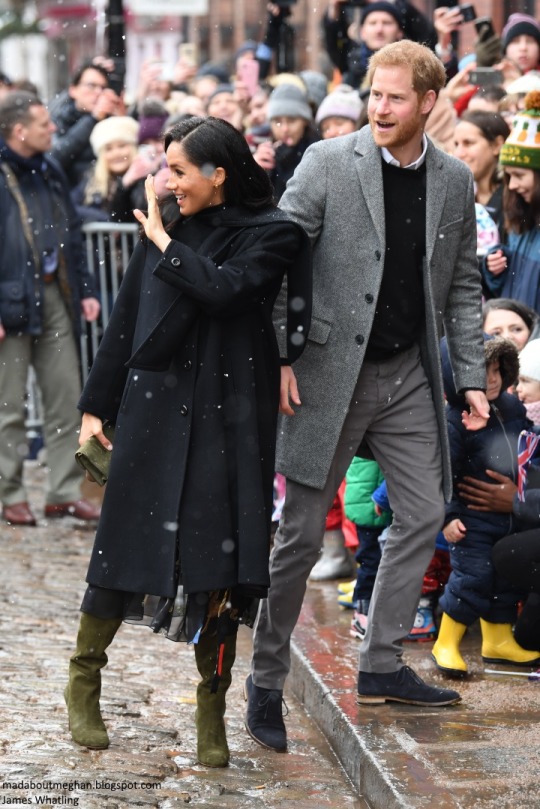
A snowy Bristol awaited the Duke and Duchess of Sussex this morning as they arrived for a day of engagements.


A terrific video from Emily Andrews captured the meeting. The little ones are adorable.
There are a plethora of interesting videos to share from today. Harry met a lady whose mother met Diana in Bristol 25 years ago. She told him her mum was “so excited she wouldn’t let go after the flowers”. Harry said: “I love that. I recognise everyone in that photo as well. Look after it.”
[embedded content]
The Duchess told well-wishers: “We’re a few minutes late, but we tried our best to get down here fast. I hope everyone gets a nice cup of tea after this. We are just so happy to be here.” Meghan revealed she was excited to visit the Old Vic Bristol theatre. She noted they have a “long-standing relationship” with her patronage the National Theatre.
Inside Bristol Old Vic they were greeted by staff. Executive Director Sally Cordwell brought her daughter Ocean to work for the day as nursery was closed due to the weather. Three-year-old Ocean stole the show after being introduced as “Ballerina”. Meghan asked her: “Is Ballerina your real name? Oh, my hands are cold thank you for warming them up. Ballerina Ocean, I think you’re going to be everyone’s favourite person today.”

When Harry met Ocean… Harry’s definitely more than ready for Baby Sussex to arrive 🙂
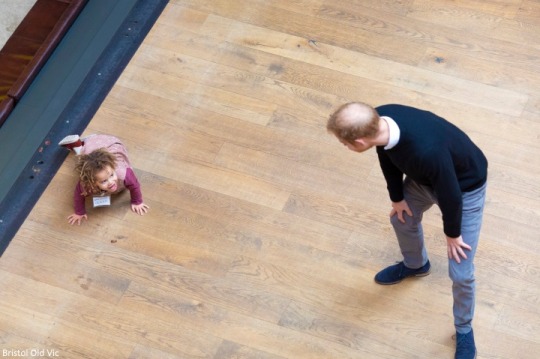
There’s footage of Meghan’s meeting with Ocean in addition to coverage of the walkabout and Old Vic visit below.
[embedded content]
Built in 1766 as a place where the people of Bristol could come together, Bristol Old Vic is the oldest continuously-working theatre in the English-speaking world.

More from the theatre on their recent redevelopment: “Our front of house has recently undergone a multi-million pound redevelopment. Our new building boasts a brand new Studio Theatre, relaxing and fully-accessible front of house space, with a bar and kitchen serving everything from tasty treats with a morning coffee to an evening meal, alongside a new interactive heritage offering – opening up the 250-year-old history of this unique building for everyone to discover and enjoy at their own pace. Our mission is to create pioneering twenty-first-century theatre in partnership with the people of our energetic city; inspired by the history and magical design of the most beautiful playhouse in the country.”

The Duke and Duchess toured the recently renovated facility, finding out more about the theatre’s unique history and links to the local community.

They also dropped in on a workshop attended by local school children which is part of Bristol Old Vic’s outreach programme.
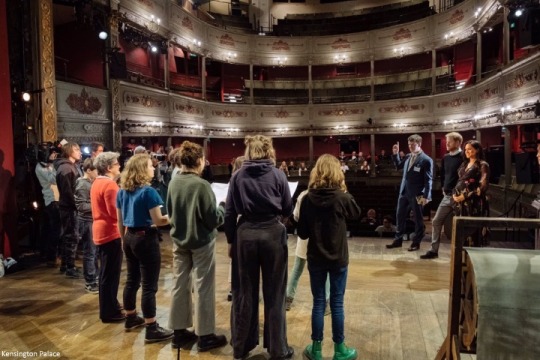
Meghan credit the theatre with providing a form for “self discovery”.

“It’s good that you have this,” she told them. “And what a beautiful space as well, it’s really special.” Referring to a short tour she had just been on with her husband Prince Harry, she added: “We were just talking about it. “There’s so much of the emphasis in after school clubs on sport. Channelling the energy you have into the creative arts and theatre and all of that is equally as important.
“Sport isn’t for everyone, just as theatre isn’t for everyone. You can know that there’s a place [here] where you can find community, and sort of explore self discovery and other things you might be thinking about.”
The Duke told youngsters of drama: “It’s more than a hobby isn’t it? It runs in your blood.” The Duke and Duchess spent more than an hour at the theatre, arriving in cold and snowy conditions but determined to undertake a walkabout so meet eager wellwishers.’
A great photo from the engagement.
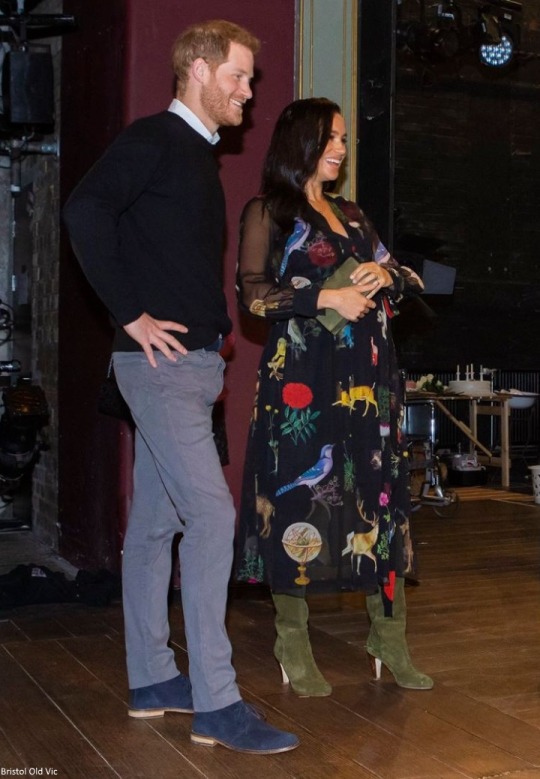
The couple were told about current performances and future plans.

To mark the visit they unveiled a plaque.
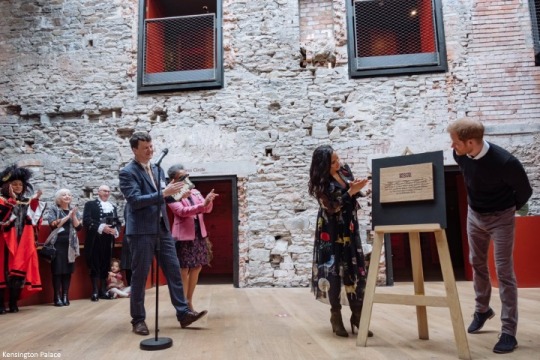
As they left, Harry escorted Meghan to the car and ran back to collect flowers. He told a group during the walkabout: “I spend my life giving Meghan flowers – from myself and from the people.”
Next on the agenda was an embargoed engagement kept under wraps until this afternoon.

The Duke and Duchess visited One25 a Bristol-based charity, specialising in enabling women to break free from street sex-work and other issues such as addiction.

One25 provide night outreach sessions, support and advocacy to over 250 women a year in the Bristol area. In terms of the difference they are making, the answer is in the statistics. Lat year, 47 women stopped street sex-working and 54 vulnerable women at risk were prevented from entering a life on the streets.
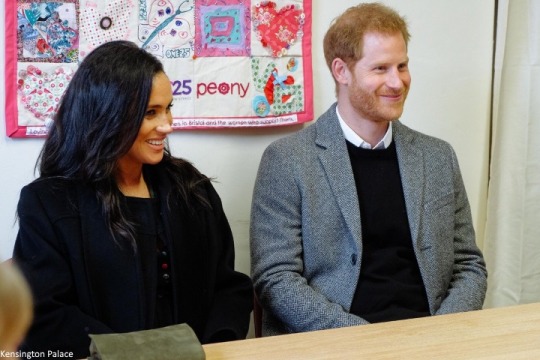
One25 work tirelessly to assist women. When asked why they are needed: “There are about 150 women sex-working on Bristol’s streets. It’s dangerous, lonely and difficult to leave. They are some of the city’s most vulnerable people, often facing several severe issues.”

One25 started in May 1995 as a result of concerns from local agencies and churches about the health and well-being of female street sex-workers in Bristol. In September 1995, One25 secured a drop-in facility one afternoon per week at the Salvation Army’s Candle Project, Lower Ashley Road. It was initiated by Val Jeal, who led a small but dedicated group of like-minded people in developing the work of forming supportive relationships with the women. In January 1996, the drop-in moved to a new temporary home in the basement of 125 Cheltenham Road, which gave the project its enduring name. Around this time a consultative group was formed with representatives from relevant agencies such as Bristol Drugs Project and the BRI’s sexual health clinic; a management team was formed and Val took on the role of Project Manager.
[embedded content]
Meghan helped prepare food bags which will be given out later tonight.
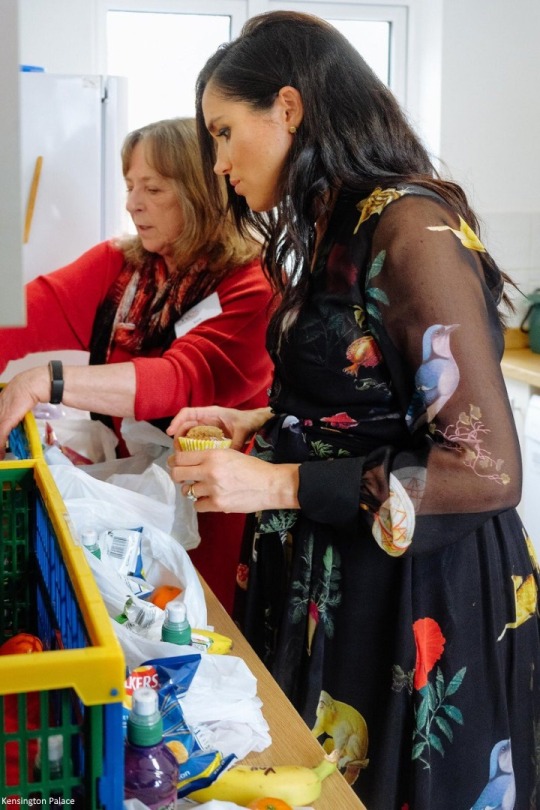
As they were assembling them, Meghan said: “I saw this project this woman had started somewhere in the States on a school lunch programme. On each of the bananas she wrote an affirmation, to make the kids feel really, like, empowered. It was the most incredible idea – this small gesture.” On the bananas, Meghan wrote ‘You are loved’, ‘You are Brave’, ‘You are strong’.

Meghan asked for a sharpie and got to work.

At 01:20 in the video below you can hear Meghan suggesting the idea.
[embedded content]
It’s thoughtful gestures like this that speak volumes and will mean a great deal to the women receiving the bags.

The Telegraph writes:
‘Declaring “I am in charge of the banana messaging!”, she wrote a series of short phrases and decorated the fruit with hearts.
One charity volunteer called Sam, who is a former sex worker, said: “I can imagine being on the van, and [ hearing] ‘Meghan wrote this thing, and what?’ I think they might not eat it. I think that banana would be at home until it is rotten. Because I would do the same.”
Anna Smith, the charity’s chief executive, told the couple: “The plight of our women is often very much misunderstood, and they are stigmatised and hidden from the world.”
As she spoke, the duchess spotted that Sam was looking nervous at the prospect of having to talk to the group. She told her: “Sometimes it is the lead-up that makes it more nerve-racking. You go first! It’s like ripping a bandaid off.”
Prince Harry, speaking of how vulnerable women can be coerced, said: “When you were being groomed at such a young age, and this is the only thing you know, you completely lose faith in society. You lose trust in every man, and probably everyone else around you. From a mental health perspective you are broken.”
More from One25 CEO Anna Smith.

Hannah Furness reports Harry told the group: “When you were being groomed at such a young age, and this is the only thing you know, you completely lose faith in society. You lose trust in every man, and probably everyone else around you. From a mental health perspective you are broken.” One25 are very much hoping the visit raises awareness and donations to ensure they can provide their services around the clock. If you would like to donate or find out more please click here.

Finally, the Duke and Duchess visited Empire Fighting Chance, which aims to fight the impact of deprivation on young people’s lives through boxing.

The charity supports children and young people aged 8 to 21 who are failing at school and in danger of drifting into a life of unemployment or even crime, and helps them turn their lives around.

Empire Fighting Chance works with around 250-300 children per week and runs programmes which help instil discipline, self control, and respect, whilst building self-confidence, life skills, and improving both physical and mental health and fitness.

The Bristol Post reports: ‘Meghan said to a group of young girls: “Do you feel strong and confident?” They replied with a resounding “yes”. The Duchess added: “You can apply the same sentiment to everything in life – just breaking it down and then you realise that you can do everything, it doesn’t seem so daunting.”‘

At one point Harry asked everyone to leave the room so he could talk privately with a boy who lost his father. People reports:
‘Harry, who lost his mother Princess Diana when he was 12, spent 10 minutes talking to Iestyn Jones about coming to terms with his grief, telling him, “The same thing happened to me.”
“It just got a bit emotional because he mentioned something. He knew some stuff about me and the same thing happened to me. We had a chat for about 10 minutes,” Iestyn, from Kingswood near Bristol, told reporters. “When we had a group picture at the end he made sure I was standing next to him. They were lovely people. I didn’t expect them to be like that. They were amazing people.”
Iestyn beside Harry in the photo.

The Duchess wrapped up in a coat from William Vintage. The London store offers vintage haute couture pieces often in pristine condition. It’s a treasure trove full of classic pieces. I seem to recall reading Amal Clooney, a friend of Meghan’s, sources quite a few items there.

A closer look at the piece.


The dress is described as:
‘Visiting The Met Cloisters museum in New York is one of Laura Kim and Fernando Garcia’s fondest memories with the late Oscar de la Renta – a sound installation they heard together inspired an ethereal Fall ’18 collection. Worn on the runway, this silk-chiffon dress is printed with flora and fauna of an enchanted forest. It comes with a detachable black slip so you don’t need to worry about the sheerness of the floaty fabric.’
A closer look at the dress on Meghan.

Meghan introduced green to the look in the form of the stylish Sarah Flint Marina Boots.

And the olive clutch she carried to Prince Louis’ christening. Laura identified it is a Ralph Lauren piece.

Meghan accessorised with her Pippa Small Herkimer diamond studs.

And a look at Meghan’s gold necklace.

The Sussexes’ ‘away days’ are becoming their signature. Today seemed particularly special encompassing another walkabout filled with endearing moments. The Bristol Old Vic visit also dovetails with Meghan’s National Theatre patronage. As is often the case with Harry and Meghan, today will be remembered for the way they connected with the people of Bristol. Be it Meghan’s incredibly touching gesture at One25 or Harry’s quotes on grooming and the impact of mental health. To see two members of the Royal family having these conversations is deeply meaningful and important.

I continue to be hugely impressed. Today was so packed with content I spent over five hours working on the post, with only twenty minutes of the allotted time spent on fashion. I think that sums up the depth and substance we saw today.
Source: http://madaboutmeghan.blogspot.com/2019/02/first-look-sussexes-arrive-in-snowy.html
0 notes